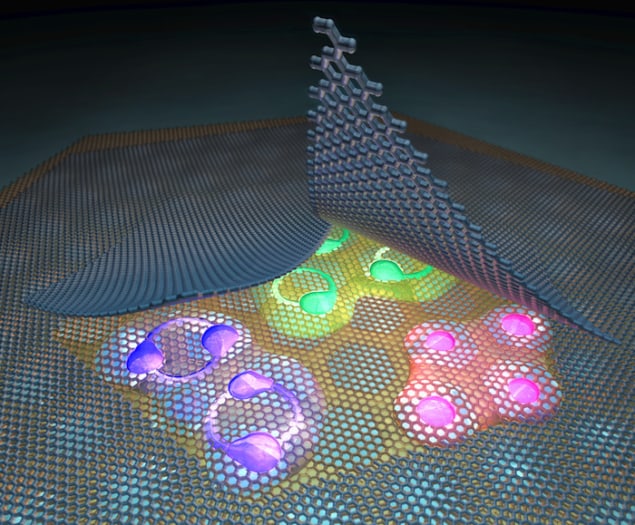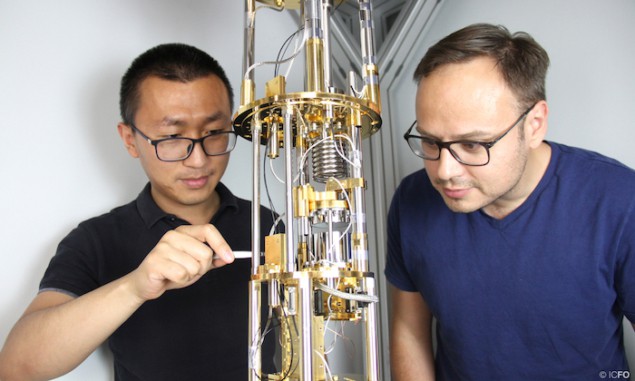
Last year, researchers at MIT lead by Pablo Jarillo-Herrero observed superconductivity in a pair of graphene layers engineered to be slightly misaligned. Now, a team at the ICFO in Barcelona, Spain, says it has seen a host of additional correlated states in the same “magic angle” system, providing a much more detailed view of how twisted bilayer graphene behaves and opening up new ways of studying strongly-correlated physics.
According to Dmitri Efetov, the study’s lead author, magic-angle twisted bilayer graphene represents a simple system in which to investigate novel phenomena that arise due to interactions between electrons in a material. The electron density in this platform can be tuned by applying an electric field, which allows the strength of the electron-electron interactions to be varied. It also allows the material to be tuned between different phases – for example, between the superconductor and the correlated state. Being able to do this could shed light on the underlying mechanisms at play in superconductors – especially high-temperature ones based on cuprates, for which a fundamental understanding is still lacking.
To create their testbed, Efetov and colleagues followed the “tear and stack” method previously developed by Emanuel Tutuc and colleagues at the University of Texas. The researchers stacked two sheets of atomic-thick carbon (graphene) on top of each other with a small angle misalignment. When the misalignment reached an angle of exactly 1.1° — the theoretically predicted “magic angle” — the MIT researchers found that the material became a superconductor (that is, able to conduct electricity without resistance) at 1.7 K. The effect disappears at slightly larger or smaller twisting angles.
Fundamentally new approach to device engineering
The MIT result kick-started a flurry of activity in “twistronics”. In this fundamentally new approach to device engineering, the weak coupling between different layers of 2D materials (such as graphene) can be used to manipulate the materials’ electronic properties in ways that are impossible with more conventional structures, simply by varying the angle between the layers.

The crystal structure of a single layer of graphene can be described as a simple repetition of carbon atoms, which is known as its unit cell. When two graphene layers are stacked on top of each other at a slight angle, they form a moiré pattern or “superlattice” in which the unit cell expands to a huge extent, as if the 2D crystal was artificially stretched 100 times in all directions. This stretching dramatically changes the material’s interactions and properties, and simply varying the angle between 2D material layers changes its electronic band structure. At small twists, the moiré graphene superlattices can even be switched from fully insulating to superconducting, as Jarillo-Herrero’s team discovered.
Improving material homogeneity
In the new work, Xiaobo Lu, a postdoctoral researcher in Efetovs’s group, improved the structural homogeneity of the bilayer twisted graphene by mechanically cleaning it to remove trapped impurities and release local strain between the layers.
When he subsequently changed the charge carrier density within a device made from the material by applying a varying voltage to it, he observed that the device could be tuned from behaving as a Chern insulator (a state where the material’s electron bands are all either filled or all empty, and for which the filled bands have a net total Berry curvature or Chern number) to a superconductor. It could also be made to form an exotic magnetic state in which magnetism arises because of orbital motion of the electron rather than (as in typical ferromagnets) the electron spin. Such a state, Lu says, has never been seen before.
Competition between many novel states
Lu explains that magic-angle bilayer graphene seems to be competing between many novel states. “By tuning the carrier density within the lowest two flat moiré bands, it alternately shows correlated states and superconductivity, together with exotic magnetism and band topology.”
The researchers say that the different states they observed are very sensitive to the quality of device. However, they do not fully understand why the material behaves this way. “For the time being, we only know that all the correlated states come from the electron-electron interaction,” Lu says. “Their ground states and the interaction mechanisms between these quantum phases remains a mystery for now.”
Another “astounding” finding according to Lu is that the device enters a superconducting state at the lowest carrier densities ever reported for any superconductor, Lu says. This result may have implications for applications such as quantum sensing, since it makes the material more sensitive to most kinds of radiation. The team have already tried to integrate magic-angle bilayer graphene into single photon detectors to make devices that might be employed in quantum imaging, bio-photonics and encryption systems, to name just three examples.
They were also able to increase the superconducting transition temperature of the material to above 3 K, a value twice that previously reported for magic-angle graphene devices.
Emergent quantum effects
“I think this a very interesting experiment,” comments Jarillo-Herrero, who was not involved in the ICFO team’s work. “The authors have found an interesting set of correlated insulator and superconducting states, some of which had not been seen before. This shows that the phenomenology of magic-angle graphene devices is even richer than previously thought.”

Researchers solve magic angle mystery
“While the origin of the new states and the differences with the results obtained by other groups remains to be understood, I believe this work will generate great interest and more experimental and theoretical work on this very exciting subject.”
Efetov’s team includes scientists from the University of Texas at Austin, the National Institute for Materials Science in Tsukuba and the Chinese Academy of Sciences in Beijing, and Efetov says they will now be focusing on investigating the superconducting mechanism in twisted bilayer graphene. “We will also be developing entirely new experimental techniques to study these emergent quantum effects in twisted low dimensional quantum materials, including graphene,” he adds.
The research is detailed in Nature.



